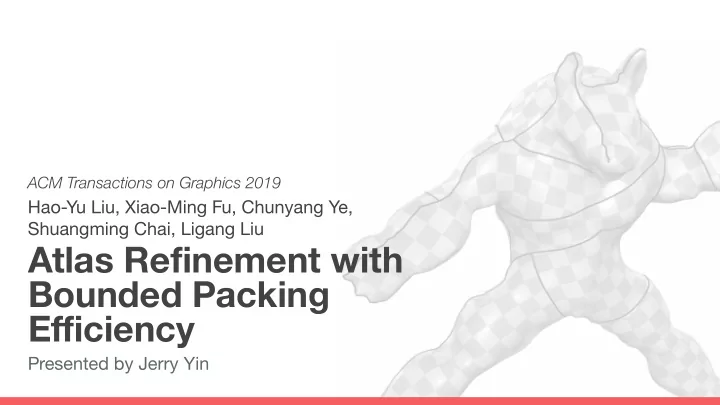

ACM Transactions on Graphics 2019 Hao-Yu Liu, Xiao-Ming Fu, Chunyang Ye, Shuangming Chai, Ligang Liu Atlas Refinement with Bounded Packing Efficiency Presented by Jerry Yin
Packing efficiency Store high-frequency information in ● rectangular 2D texture images. Textures are mapped to 3D surfaces ● using UV coordinates. Unused parts of the image are wasted ● A texture atlas is composed of charts . ● Packing efficiency is ● area(atlas) / area(atlas bounding box). Model by Geoffrey Marchal.
Packing problem Fixed boundary parameterization can give ● perfect packing efficiency, but has high distortion. Making each triangle its own chart gives zero ● distortion and good packing efficiency, but leads to poor performance and potential artifacts. We want ● high packing efficiency, ○ low distortion, and ○ short boundaries. ○
Algorithm overview Given an existing texture atlas: Input 1. Deform input charts so that their boundaries are axis-aligned. 2. Cut axis-aligned charts into rectangles. 3. Pack rectangles. 1 2 4. Relax boundaries of rectangles to reduce distortion. 3 4
Axis-aligned boundaries Want to make boundary edges of all charts axis- ● s i aligned. To minimize corners, (Gaussian) smooth direc- ● chart tion of all boundary edges. Each direction is repeatedly set to weighted ○ . . . average of neighbourhood’s directions. Find optimally axis-aligned rotation R of each ● chart by optimizing where
Aside: Gauss-Bonnet theorem α i : interior angle at vertex i ● Corollary: if we increase the interior ● angle somewhere, we must decrease it by an equivalent amount somewhere else (possibly in multiple places).
s i Axis-aligned boundaries (cont’d) s i + 1 α i Γ ( s i ): closest axis direction to s i ● chart Update each interior angle α i to be ● . . . Result may have foldovers ( α i ≤ 0). ● s i + 1 s i Find boundary verts ( α j = 180°) adjacent to α i , ○ and set α j = 90° and add 90° to α i . More optimizations: corners can be merged or ● chart moved sometimes to reduce distortion. . . .
Chart deformation preserve preserve already lengths obtained angles weight according to length Interior vertices need to be adjusted. ● Minimize sum of E align ( c ) (to get close-to-axis- ● aligned boundaries) and symmetric Dirichlet energy (to minimize isometric distortion) for chart c . Afuerwards, snap the result Increasingly prioritize E align ( c ) as we iterate. ○ to be exactly axis-aligned.
Cutting charts with motorcycles Motorcycle starts at a corner and travels in a ● straight axis-aligned line, and stops when it hits a boundary or the trail of a different motorcycle. For each two consecutive interior edges of a ● corner, at least one edge must be assigned a motorcycle in order to get a rectangular partition [Eppstein et al. 2008]. Partition not unique (choice of motorcycle ● assignment and ordering).
Cutting charts with motorcycles (cont’d) Generate motorcycle decompositions at random. ● Pack rectangles with small padding around ● boundary (useful later). Evaluate each packing with score ● Pick one with highest score. ●
Relaxing the boundaries Based on scaffolding method [Jiang et al. 2017]. ● Triangulate empty space, then minimize ○ symmetric Dirichlet energy. Allows maintaining padding around charts. ● Useful for subsequent applications. ○
Results
Results
Boundary length elongation. Timings (runtime (ms?) / # vertices). Isometric distortion Isometric distortion w/r/t original mesh. w/r/t input atlas.
Recommend
More recommend